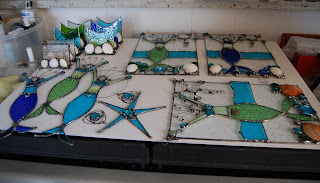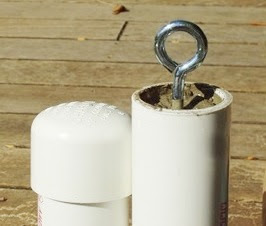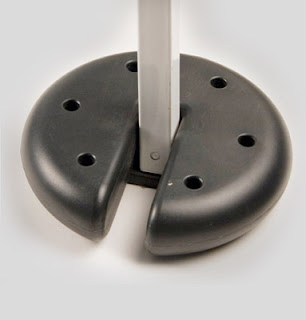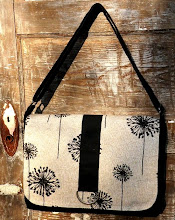Ok, so I decided to splurge and invest in a real chair to bring to craft shows, one where people can actually see me sitting behind my display. After researching online, I went to my local Mill Store to purchase a director's chair and they told me they're no longer carrying them. Apparently, not a big seller (kind of an odd thing to say to a customer looking to purchase one...) Anyhoo, if you're looking for a new director's chair/barstool, they're available AND on sale ($59.99) thru the end of May at Pier 1. Fabric is sold separately ($9.99).
Tuesday, May 25, 2010
Monday, May 17, 2010
Twist + SoWa Artwalk
In the past 2 weeks, I visited Northampton for Twist IV (above) and stayed closer to home this past Saturday for the ever fabulous SOWA Artwalk. I had a great time in Northampton and hope to head back to that area again soon. My immediate neighbors at Twist IV were Scott from Bunny Butt Apothecary
and Sarah from Ansel Blue Design Studio (Sarah is sadly missing from the photo...)
They were fantastic company and I didn’t even notice that I was next to a speaker (AGAIN!). Though this time, the music was just right… ambient and pleasant. Thanks Lexie!
The past few years I’ve participated in a group art space for the Sowa Artwalk but this year, it was a little different and the group space was eliminated (boo hoo). Each year we moved locations from one vacant building to the another but I guess the vacant property is scarce these days and that’s good news for the property owners/developers and the area in general.. but sad news for many artists as the area becomes more developed and the real estate prices increase. Affordable space is much harder to find (yikes). BUT, now there’s a fabulous contemporary art destination in Boston's South End with lots of galleries and studios all clustered in one neighborhood called SoWa (stands for South of Washington).
I was a guest artist at 59 Wareham Street (above), home to 4 floors of working artists including Shoshana Ernst (painter) and Jenn of Jenn Sherr Designs who invited me to share their studio space on May 15th. Thank you ladies! We had lots of fun discussing art and making signs for the event, and it was a toss up whether my favorite part of the day was hanging the wet signs in the wind OR convincing Jenn that we should use the freight elevator (she’d been warned NOT to take it… ah, so what if we get trapped??). Turns out the freight elevator works like a charm and definitely made transporting my stuff to the 3rd floor MUCH easier!
super windy on Wareham Street! That sign was going wild!!
I think our colorful (awful) sign with blue tape was effective... right? Definitely attention grabbing!
Anyway, I ended the day on the Red Fez patio with good friends Jaime + Ken and a lovely glass of vino. Perfect ending to a great day of art. Then up early the next morning for a full day in the studio, working on orders to ship off to stores…
Wednesday, May 12, 2010
10 Tips for Outdoor Craft Shows
In addition to creating amazing products, setting up an inviting display, and being pleasant and friendly, there’s a whole set of other issues to worry about when preparing for an outdoor craft show. Here are some tips based on my experiences. Feel free to accept this information, share with others or tell me that my suggestions stink:
1. Toolbox - I keep a toolbox in the car filled with things I might need including: duct tape, hammer, screw drivers, spring clamps, push pins, paper clips, scissors, string, sunscreen, bug spray, bandaids, Claritin, Advil, pens, safety pins, tissues/baby wipes, bungy cords/rope, female necessities (ladies, you know what I’m talking about…). While it sounds like I’m preparing for something nefarious, I’ve found it’s comforting to have these items on hand all in one place even if I never need them. However, when you need them, it’s so helpful! For example, duct tape is a perfect temporary fix when a support section of your tent (or your neighbor’s) snaps while setting up or you need a spring clamp to “button up” your tent for the night because the zipper for your side walls breaks. Oh, and I also have a couple of towels in the car too just in case it starts pouring…
2. Tents – there are a range of options when it comes to purchasing 10’ x 10’ tents. Price is obviously the main factor (and frankly, prepare to spend at least $200 for a good tent – otherwise, buyer beware!!); however, there are structural, weight and durability considerations as well. Deciding which tent is right for you will depend on your product line, how you plan to display your items and how many shows you will do. Questions to ponder:
- How much do you want to spend?
- Is your set up primarily table top, walls, or a combination?
- How much protection from the elements do you and/or your items require?
- How handy are you?
- Assuming you have a vehicle, how much room do you have in your vehicle?
- Do you plan on doing one-day shows only or 2 and 3-day shows as well?
- Do you plan to use the tent just a few times or for many years to come?
- Do you want a waterproof tent or one that just protects you from the sun?
Tent Interiors - have either an “open roof design” which is a tent that has no interior visible frame elements, kind of like a cathedral ceiling (e.g. Quick Shade, Trimline) OR a “cross truss frame design” which is a tent with exposed interior frame elements, kind of like a drop ceiling made of metal cross bars (e.g. EZ UP). If you want to be able to hang (lightweight) items inside your tent, then go with the cross truss design (EZ UP). The overhead space is lower than the open roof tents but you have the option to hang items. Generally speaking, a tent requires 2 people to set up but I’ve seen vendors set up the cross truss frane style tents themselves by opening the tent partly, going underneath the tent and pressing up from the middle.
Tent colors – Get a white tent. Why? Because it’s bright, airy, provides the best natural lighting and a clean back drop for your items. Also, some shows require a white tent.
Tent fabric – most of the tent canopies are NOT waterproof (errr…) so if you choose a tent that’s water resistant or a “sun blocker”, you’ll probably want to spray your canopy with a waterproof sealant. I’m not sure why the tent manufacturers can’t offer waterproofing as an option for an added fee (like when you buy a couch) because spraying a 10’ x 10’ section of fabric is not exactly easy especially if you live in a city… But it’s worth doing because there’s nothing worse than trying to protect your items in heavy rain as the canopy fabric becomes saturated and drops of water fall inside the tent.
Tent Options
Below are 5 brands of tents to consider. There are more companies out there but these are the brands I see most often at shows. The prices vary considerably and keep in mind that if you want something sturdy and well made that will last for more than one season, select a commercial grade tent. Also, search online for the best price and free shipping once you decide on the brand and model you want. The deals are out there!!!
(canopy is a cross truss frame and water resistant, can hang lighter items inside on the cross beams, easy tent to set up)
(canopy is an open roof design, vented and water resistant). Though the vented canopy does let trapped air escape and is super cute, the initial set up is a pain in the you know what. In comparison to other tents that have one giant piece of fabric, the canopy is composed of 3 separate pieces and the initial set up is a little tricky/award, especially the smallest piece on top - it helps if you're tall or have tall helpers with strong hands. Also while some people take their canopy off the frame after each use, I leave the canopy attached to the frame at all times.)
Looks like this tent is quite a deal at Walmart.
(Disclosure - I have this tent and it’s solid, sturdy and will definitely last. Just wish the top was waterproof… otherwise, I luv my tent.)


(canopy is an open roof design and 100% waterproof)
(canopy is water resistant, can hang lighter items inside on the cross beams, easy tent to set up)
(canopy is an open roof dome design, very heavy duty, 100% waterproof, more time consuming to set up – need to be handy as components are screwed together. I suggest wearing gloves while setting up. This is NOT a pop-up. much higher priced than the pop-up tents but built to last) $845
Tent Components
Mesh Panels (pictured below in an EZ UP tent) - For painters, photographers, printmakers, etc., I highly recommend Flourish Company’s mesh panels. Yes, they’re expensive ($223 for one -$640 for three) but they’re compatible with the various brands of pop-up tents and not just the Flourish Trimline tents. (as an aside, Flourish actually has people who answer the phone and talk to you about your order. What a concept?) Anyway the mesh panels come with a cross bar which screws into place along the base of the tent and helps to stabilize the tent and makes the mesh wall rigid. Again, the mesh walls are expensive but they roll up and the fabric walls are easier to schlep around than metal grid walls.
Grid Walls (pictured below displaying Saya Studio’s handbags) Metal grid walls come in a variety of colors and sizes depending on how you want to set up your display. I’ve ordered from this company before and you can check out their site to get an idea on sizes, price, etc. But google grid walls and you’ll find a bunch of options.
Sidewalls – All of the tents mentioned above have the option of purchasing 1-4 sidewalls. Some tents come with and others you have to order the walls separately. Walls are essential if you want a crisp, white backdrop for your display, to protect your items when it’s raining or you plan to “button up” your tent and leave it up overnight for a 2 or 3-day event. By the way, I wouldn’t advise leaving your product in your tent overnight unless you don’t care if it gets stolen, damaged or blown away. I always pack up my stuff but many others don’t. Anyway I was trying to cut corners and I purchased tent walls separately on ebay (random brand) and I regret it. I did save a few bucks but if I could redo that purchase, I’d fork up the extra cash and buy the walls that are specifically designed for my tent. When it’s time for me to use all 4 walls, it’s kinda like squeezing into jeans that are WAY too tight if you catch my drift… not pretty like the pic below..
p.s. if the weather is questionable, attach your tent walls during set up and roll them up. (I use a bunch of spring clamps to accomplish this). Then they’re ready to unroll in a pinch if the weather changes.
3. Portable dolly or Hand Truck – Get one!! Your hands, back and product will appreciate this purchase especially if you have heavy or fragile items and your final destination is far from your vehicle. As with most things, you get what you pay for and I’d recommend paying a little extra for something heavy duty. p.s. bigger wheels are easier to navigate over bumpy terrain.
Oh, one more thing, make sure you have room in your vehicle/truck for this super clunky but oh so handy device. Even though it seems like a dream, if you don’t have room for this sucker, you’ll be miserable trying to make it fit. I know it’s a little backwards, but I’ve found that I have to pack my handtruck FIRST for a stress-free load-in and out. I LUV my handtruck!
You need weights to hold down your tent. Many shows require them so please don’t be the a**hole without weights with the tent that flies away and lands on someone’s car, knocks over another vendor’s tent or a crashes into a show attendee. I’ve seen it happen folks. NOT cool!
Option #1: set of 4 weight bags. (Pictured above: EZ-UP brand). There are several companies now selling these online (google ‘tent weights’) and for a set of 4, you can expect to pay between $40-70. For a good deal from King Canopy, click here. The good thing about these bags is they’re made out of fabric and are equipped with Velcro straps so you can easily attach a bag to each leg of your tent. The downside is you have to fill each bag with sand or rocks (not so much fun) and since the whole point is for them to be as heavy as possible (ideally 40 lbs each) you need to get your hands on a substantial amount of heavy filler. If anyone’s interested, I live near the beach (hint, hint)..
Option #2: make your own weights with PVC pipes and concrete. If you’re handy, these are a great alternative and personally, I think they look nicer than the weight bags. You’ll need:
• 4 PVC pipe (at least 3’ for each leg)
• 4 or 8 PVC matching end caps (purchase flat bottom caps so the final pieces sit flat - if you want the top to have a top cap as well, purchase 8 caps, not 4, and make sure to screw a hole for the eye hook – this is a cleaner look but a little more work)
• Glue/epoxy (anything that works for plastic)
• couple of bags of Quick Crete
• 4 large eye hooks
• Bucket (for mixing concrete)
• Garden trowel (to scoop the concrete into the PVC
• Drill (if you’re gonna screw a hole in 4 of the PVC caps)
To make: glue the end caps on one end of each pipe; mix up the quick crete with some water; fill the PVC pipes with the quick crete; insert a large eye hook into the center of each filled pipe and let dry for a couple of days. (getting crafty – if you decide NOT to use a top cap, you may want to add some flair to the visible concrete top surrounding the eye hook before it dries… think tumbled stones, glass beads, sea glass, tiles, googly eyes, etc…)
To attach to your tent: use 4 pieces of rope, chain or ratchet straps that are long enough to attach to the pipe at the eye hook and then go up and over the corner of your tent in each corner. You can also Velcro the weights to the leg posts.
Option #3: I’ve also seen vendors using round, stackable discs that fit onto each leg. Looks like Quickshade sells these "weight plates" (4 plastic coated discs weighing 5 lbs each for $44). And this ladies and gents appears to be the most expensive option. (Oh! Hold your hats. I just received the following helpful feedback regarding this product: "in the wind, the discs skid around on concrete... they are useless" - ok then. I guess this is NOT a good option)
Additional Stabilization: When you’re on grass and you plan to stay put for 1 super windy day or 2-3 days, another item to help secure the tent is this handy device (spiral stake). The tent companies sell these but you can also get them at pet shops or Ocean State Job Lot.
4” – 6” Spring Clamps – good to have on hand for a number of quick fixes. Can be found in hardware stores, Ocean State Job Lot, or online.
5. Mailing List and business cards: Have business cards on hand to pass out (or for little kids to collect from every vendor and leave on the ground...) as well as a small book or piece of paper to collect names for your mailing list. To send emails with photos, links, etc, for news and upcoming shows, you can use companies like:
MailChimp (free)
Constant Contact ($15/month and up)
Campaigner ($10/month and up)
They all offer free 15-30 day trial periods so take advantage of this option and see which one you like the best. Once you sign on with one of these companies, you can create a “join my mailing list” link to add to your website.
6. Event / Liability Insurance – just a suggestion… better safe than sorry. These are companies I'm aware of that offer insurance for artists/crafters:
ACT Insurance (I use them)
6. Event / Liability Insurance – just a suggestion… better safe than sorry. These are companies I'm aware of that offer insurance for artists/crafters:
ACT Insurance (I use them)
7. Body and Belly comfort: Pack a small cooler with water and some nibbles in case food and drink is not easily accessible… and this is especially important if you’re like me and don’t eat hamburgers and hotdogs like other normal people (ie. vegan, gluten free, etc). Handwipes or hand sanitizer is also nice to have since touching money and then eating is yucky. Also dress in layers in preparation for the ever-changing weather conditions.
8. Productivity: I abhor wasting time so I always try to bring things to do just in case there are slow parts of the day. So if you have prep work you can do while sitting in your tent, people can see you working on your craft which is interesting PLUS you’re getting things done. It’s win, win!
9. Travel: If you’re heading to an area and will be staying away from home, get in touch with the event organizer first to ask for referrals or advice on hotels, restaurants, etc. Sometimes this can be very helpful, other times… not so much. Oh, and I’d definitely recommend trying Priceline for booking travel arrangements. I just did a show and found out my neighbor paid $50 (versus my $120) for the same hotel! WTF?
10. Change/Cash box/Credit Cards: Make sure you have a bunch of small bills ($1, 5 and 10) to start off the day especially if you don’t accept credit cards. You don’t want to lose a sale because your first customer has a $100 bill to pay for a $15 item and you have no change. Hey, it happens… so be prepared.
If you’re thinking about accepting credit cards, there are many, many options and it can be sort of overwhelming to figure out the best plan for you. Aside from selecting a merchant account (that's the company that handles the financial transaction and charges you a fee for this service), you also have to decide whether you want an instant authorization system (aka swipy thing) or a virtual terminal (that's when you imprint the credit card with a knuckle buster (see below) or receive the credit card information by phone/email and then YOU key in/call in the entry after the sale):
Square UP ok, so I was hesitant at first; however, I'm now a believer and user of this device/service. Device fee: FREE, 2.75% flat rate, plus $.15 fee per transaction. Works with an iphone/ipad.
Propay
start up fee: $0, basic plan: $34.95/annual fee (3.5-2.6% - the percent you're charged decreases as your monthly total increases) plus a small transaction fee
start up fee: $0, basic plan: $34.95/annual fee (3.5-2.6% - the percent you're charged decreases as your monthly total increases) plus a small transaction fee
Paypal
start up fee: $0, basic plan: $30/month (3.1-2.4% - the percent you're charged decreases as your monthly total increases) plus a small transaction fee
start up fee: $0, basic plan: $30/month (3.1-2.4% - the percent you're charged decreases as your monthly total increases) plus a small transaction fee
Merchant Warehouse
start up fee: $179; monthly fee & transaction fees are negotiated with customer service (the monthly fee is less than $30/month).
start up fee: $179; monthly fee & transaction fees are negotiated with customer service (the monthly fee is less than $30/month).
(If you decide to go with Merchant Warehouse, please tell them I referred you – thanks!)
Below are the fee structures for Propay and Paypal for a VIRTUAL TERMINAL.
Below are the fee structures for Propay and Paypal for a VIRTUAL TERMINAL.
The process of signing on with a credit card merchant can be overwhelming and finding out their fee structure can be similar to buying a car in some respects so be prepared for the maze of confusion. There are fees beyond the basics which are available on their respective websites if you look. Bottom line, whatever plan you choose, you are increasing your potential sales by offering the option to customers. Offering this payment option does chip away at your profit and you have to be careful but it's well worth it.


Imprinters: I use the ever trusty credit card imprinter (above) but many vendors use wireless machines nowadays. It takes a wee bit more time and effort, but I find the “knuckle buster” (around $14) is fine, cost effective and I actually prefer to have the imprint of the credit card as proof of the face to face transaction. Should you decide to go with this oh so high tech model, I’d also recommend ordering a truncated 2-part sales slip (below). With all the concern about privacy and protecting one’s information, do the right thing and provide your customer with a sales slip that does NOT have her credit card number on it. It’s a few bucks more but well worth it…
Lastly, I keep all my receipts and moolah in one place (shh.. it’s a secret), and I’m very aware of where that “place” is at all times. Other vendors like to keep their receipts and cash on them and a cute little apron is the perfect solution to hold such valuables. You may even find your neighboring vendor selling such an item...
Speaking of receipts, paperwork and credit cards... just something that exhibitors/sellers/small business owners don't necessarily know about until it happens to them is called a CHARGEBACK. This is when you sell an item to someone and at some point down the road, you're informed that the customer reported your transaction as fraudulent. Since this topic is worthy of its own post, click here for more information.
Well... I hope this information is helpful to newcomers and seasoned vendors alike. Again, feel free to add your comments and feedback and I will update this post as new information comes in.
Subscribe to:
Posts (Atom)




































